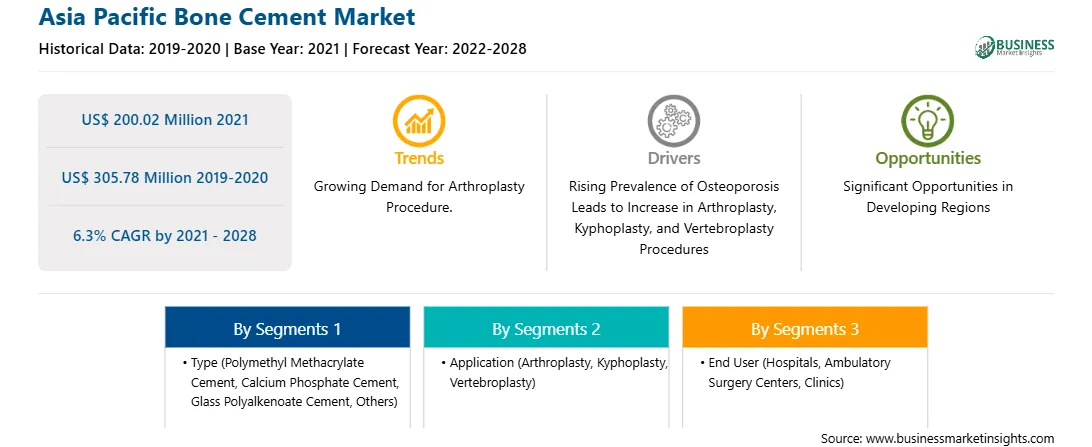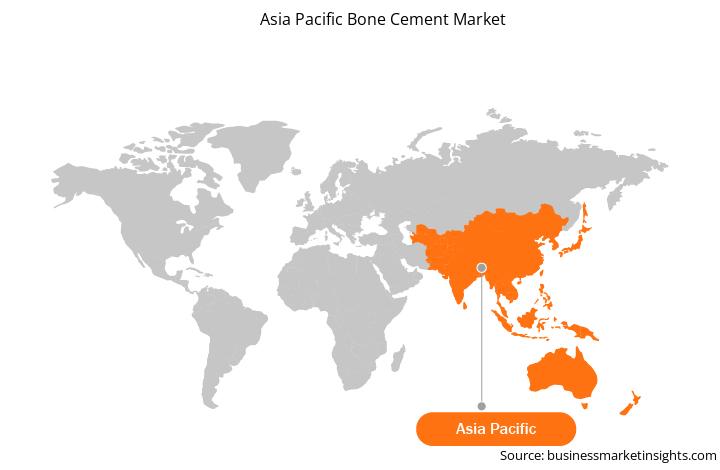The rising demand for kyphoplasty, arthroplasty, and vertebroplasty surgeries is expected to increase the sales of bone cement. Leading market players across the region are increasing their penetration across emerging markets by expanding their distribution networks and augmented manufacturing capabilities. Emerging markets across the region are expected to offer potential growth opportunities for key bone cement manufacturers in the years to come. This can be attributed to the rise in the aging population, high prevalence of osteoporosis, increased disposable income, improved healthcare infrastructure, and growth of medical tourism in several countries. Several emerging countries across the region have become business-friendly and adaptable hubs due to relatively less stringent regulations and data requirements. Most players are shifting their focus to emerging markets. High investments in life science and health research in emerging countries play a key role in upgrading the latest technologies in these countries. This factor, in turn, supports the inclination toward bone cement use, thereby driving the APAC market growth.
The COVID-19 pandemic significantly affected the clinical and surgical practice of orthopedic surgeons in the APAC region. Clinics were closed, or the practice hours were reduced. Similarly, surgical theaters were closed, reduced, or limited to semi-emergency and emergency surgeries. During their clinical practice, orthopedic surgeons were moderately concerned about contracting COVID-19 but were extremely concerned about transmitting this disease to their family members. The APAC countries, with their large and socioeconomically varied populations and infrastructures, were among the earliest to have to respond to the COVID-19 pandemic. Although the disease is not one of surgical trauma, its effects on orthopedic injuries have been notable. Medical systems had to adapt to better focus on patients with a highly communicable disease while providing essential services. Even though many countries saw a decrease in traumatic injuries during the initial periods, orthopedic trauma services nevertheless had to adapt to system-wide organizational changes. While each country took its individual approaches to address the pandemic, there were also consistencies in how musculoskeletal injuries and conditions were managed during these early stages of the pandemic. The pandemic affected three main aspects of the global economy – manufacturing, supply chain, and business and financial markets. Japan, China, South Korea, India, and Australia were the hardest-hit countries due to the rising number of COVID-19 cases and related deaths.
With the new features and technologies, vendors can attract new customers and expand their footprints in emerging markets. This factor is likely to drive the APAC bone cement market. The APAC bone cement market is expected to grow at a good CAGR during the forecast period.
Strategic insights for the Asia Pacific Bone Cement provides data-driven analysis of the industry landscape, including current trends, key players, and regional nuances. These insights offer actionable recommendations, enabling readers to differentiate themselves from competitors by identifying untapped segments or developing unique value propositions. Leveraging data analytics, these insights help industry players anticipate the market shifts, whether investors, manufacturers, or other stakeholders. A future-oriented perspective is essential, helping stakeholders anticipate market shifts and position themselves for long-term success in this dynamic region. Ultimately, effective strategic insights empower readers to make informed decisions that drive profitability and achieve their business objectives within the market.

| Report Attribute | Details |
|---|---|
| Market size in 2021 | US$ 200.02 Million |
| Market Size by 2028 | US$ 305.78 Million |
| Global CAGR (2021 - 2028) | 6.3% |
| Historical Data | 2019-2020 |
| Forecast period | 2022-2028 |
| Segments Covered |
By Type
|
| Regions and Countries Covered | Asia-Pacific
|
| Market leaders and key company profiles |
The geographic scope of the Asia Pacific Bone Cement refers to the specific areas in which a business operates and competes. Understanding local distinctions, such as diverse consumer preferences (e.g., demand for specific plug types or battery backup durations), varying economic conditions, and regulatory environments, is crucial for tailoring strategies to specific markets. Businesses can expand their reach by identifying underserved areas or adapting their offerings to meet local demands. A clear market focus allows for more effective resource allocation, targeted marketing campaigns, and better positioning against local competitors, ultimately driving growth in those targeted areas.

APAC Bone Cement Market Segmentation
The Asia Pacific Bone Cement Market is valued at US$ 200.02 Million in 2021, it is projected to reach US$ 305.78 Million by 2028.
As per our report Asia Pacific Bone Cement Market, the market size is valued at US$ 200.02 Million in 2021, projecting it to reach US$ 305.78 Million by 2028. This translates to a CAGR of approximately 6.3% during the forecast period.
The Asia Pacific Bone Cement Market report typically cover these key segments-
The historic period, base year, and forecast period can vary slightly depending on the specific market research report. However, for the Asia Pacific Bone Cement Market report:
The Asia Pacific Bone Cement Market is populated by several key players, each contributing to its growth and innovation. Some of the major players include:
The Asia Pacific Bone Cement Market report is valuable for diverse stakeholders, including:
Essentially, anyone involved in or considering involvement in the Asia Pacific Bone Cement Market value chain can benefit from the information contained in a comprehensive market report.